“Magic Mirror on the wall, who’s the fairest of them all?”
The obvious answer to this is, of course, Snow White. Though that answer could also be Walt Disney. On December 21, 1937, Walt took the biggest risk of his life when he released a groundbreaking new film, Snow White and the Seven Dwarfs. With the odds stacked against him, and the critics ready to pounce, Walt took three years of labor (and an overdrawn budget ready to sink his studio), and put it all on the line at the Carthay Circle Theatre in Los Angeles.
The result was the beginning of a film revolution. Snow White would be the first of many successful Disney animated feature films, and it ushered in the dawn of animation in feature films worldwide. Inspiring countless imitations and remakes over the decades, Snow White remains to this day one of the most revered and influential films of all time. With Disney’s recently released live-action remake of the animated classic trying to find its way in the box office, let’s enjoy five(ish) fun facts about Disney’s first animated feature film – Snow White and the Seven Dwarfs.
Proving Ground
Throughout his life and career, Walt Disney maintained the heart of a pioneer. He was always on the cutting edge of animation and storytelling, and Snow White is the biggest demonstration of Walt’s animation innovation.
But Walt and his animators needed to learn to crawl before they could walk. To do this, Walt used his “Silly Symphonies” animation series as a way to try out new techniques and material. In preparation for Snow White, Walt used the 1934 Silly Symphony short The Goddess of Spring to practice realistic human animation. While trying to animate the female goddess Persephone to look as human as possible, animators fell well short of the realism that would be celebrated in Snow White. After realizing that a greater knowledge of anatomy was required in order to produce believable human animation, Disney hired fine artist Don Graham, who conducted anatomy classes in order to instruct animators on the fine art of human animation.
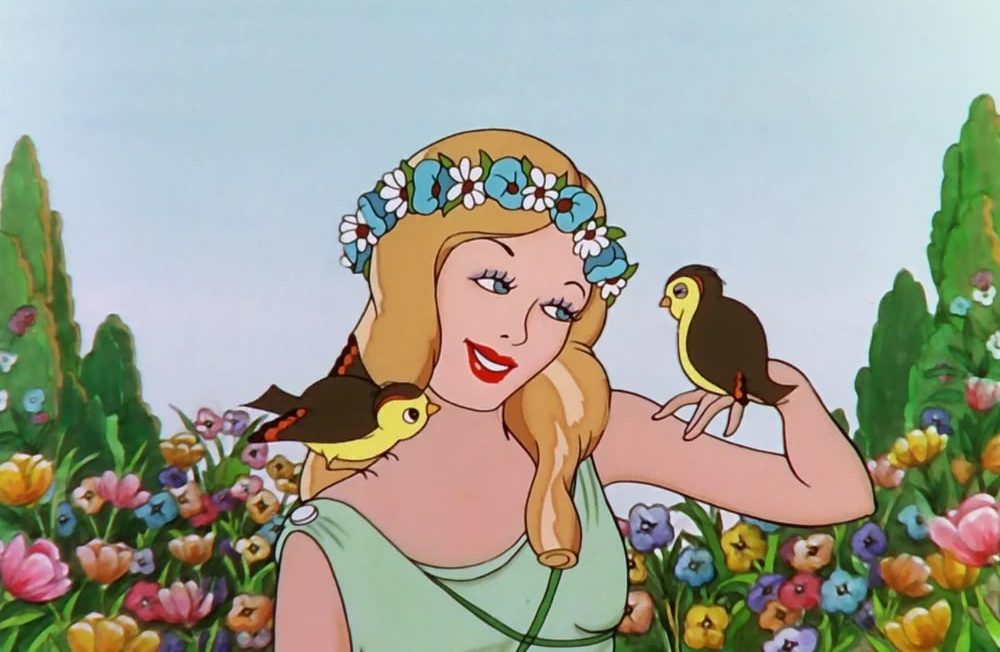
The lessons learned from animating The Goddess of Spring, combined with the studio anatomy education, proved to be the intermediate steps necessary to allow animators to perfectly animate the human characters in Snow White.
A Pioneering Film
With some of the animation kinks worked out, it was full speed ahead for Walt and his animators. But “full speed ahead” took quite a long time – about three years, in fact. The lengthy production time proved to be time well spent, when Walt’s team finally reaped the fruits of their efforts.
Walt’s Folly Becomes Walt’s Victory
Walt firmly believed in his assertion that America was ready to enjoy a full-length animated feature film. Figuratively speaking, Walt “bet the house” on his vision. The film’s initial budget of $250,000 was huge for films in the 1930s – and it was about ten times the average budget for one of the Disney Studios’ Silly Symphonies shorts. Over the course of the production, the film’s final budget ballooned to over $1.4 million – almost six times the initial budget. Critics and pundits within the Hollywood film industry were convinced Walt would fail, and referred to the project as “Walt’s Folly.” But Walt never waivered, leveraging the financial fate of the entire Disney Studios on his gamble.
In the end, Walt’s determination paid off. Snow White earned $8.5 million in theaters – four times as much money as any other film in 1938 – and it held the title of highest grossing film ever for a full year, until it was knocked out of the top spot by the 1939 film Gone with the Wind. Fun Fact: When adjusted for inflation, Snow White remains the highest-grossing animated feature film of all time.
Walt used the profits from Snow White to build a new studio building in Burbank, California. The Team Disney building, located on the Burbank studio campus, proudly honors the success of Snow White by sporting all seven dwarfs holding up the building’s roof.
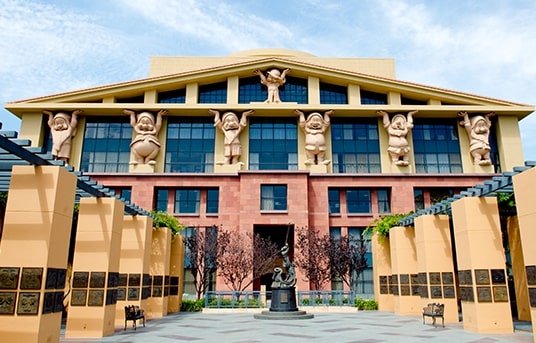
A Film of Firsts
I’m not sharing any groundbreaking news when stating that Snow White was the first full-length animated feature in motion picture history. It was also the first produced in full color. But what is staggering is the effort involved in bringing this film to life. Looking at the production numbers – publicity materials available at the time of the film release stated that the production employed over 500 artists, including 32 animators, 102 assistants, 167 “in-betweeners”, 20 layout artists, 25 artists doing water color backgrounds, 65 effects animators, and 158 female inkers and painters. Overall, about 2 million illustrations were created, using 1,500 different shades of paint. Bringing Disney’s first animated princess to life was truly a Herculean effort.
Musically speaking, Snow White was the first film to ever have an accompanying soundtrack album (the fact that the film was nominated for Best Musical Score gave the soundtrack idea wings to really fly). Prior to this groundbreaking film, a movie soundtrack album was unheard of in the industry, and the idea of an accompanying soundtrack held little value to film studios. Once again, Walt and his team were on the cutting edge of entertainment innovation.
At the 11th Academy Awards ceremony in 1939, there was no such category as “Best Animated feature Film.” But Snow White was recognized with an Honorary Award for Walt Disney as “a significant screen innovation which has charmed millions and pioneered a great new entertainment field.” The memorable award was a unique design – one full-size Oscar statuette alongside seven miniature ones – and was presented to Walt by 10-year old child actor sensation Shirley Temple, to which Walt exclaimed “Well I’m so proud, I think I’ll bust!”
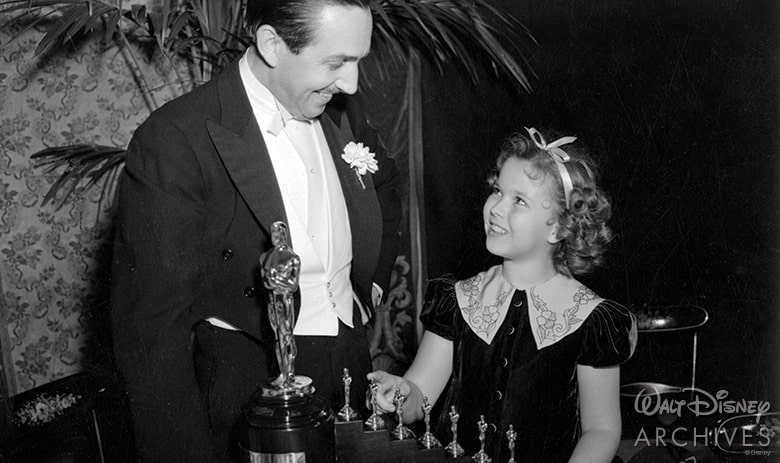
In yet another first – Snow White was the first animated feature film to be selected for the National Film Registry, for being “culturally, historically, or aesthetically significant.”
Snow White – The Fairest of Them All
What would a celebration of Snow White and the Seven Dwarfs be without recognition of the princess herself?
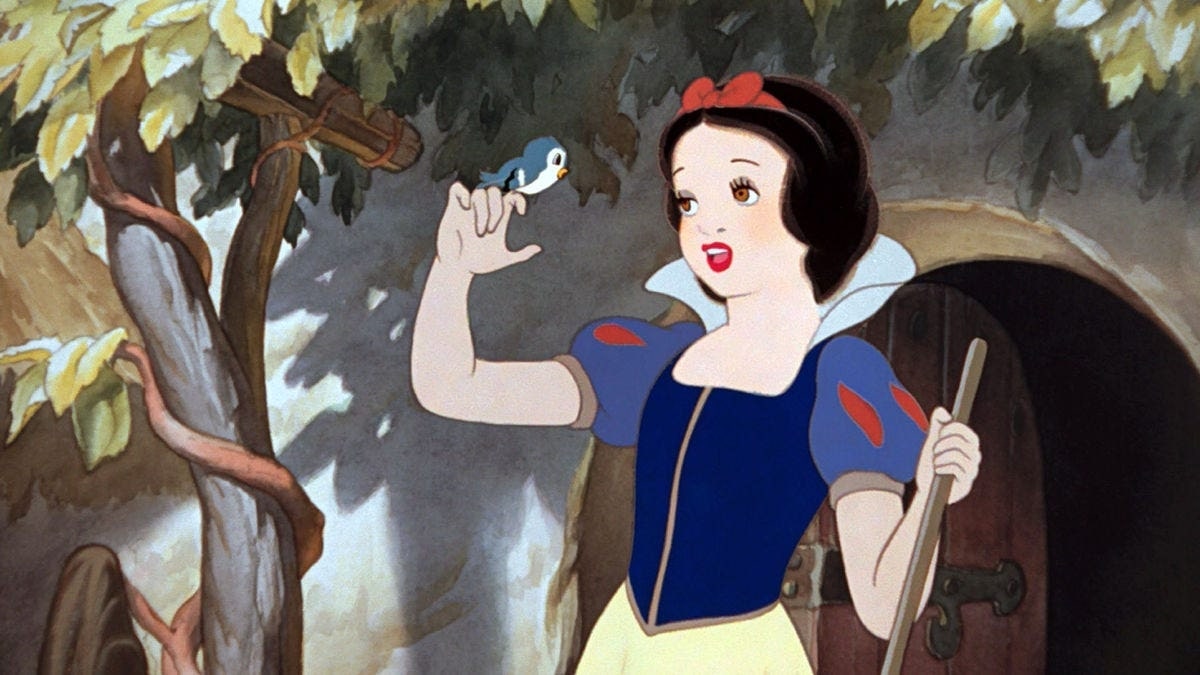
Snow White is officially the youngest Disney Princess at the age of 14, and she was voiced by 18-year-old Adriana Caselotti. At the time of the film’s release, Walt protected Caselotti from the expected media frenzy by keeping her anonymous. Walt also wanted to keep Snow White’s voice unique, so he held Caselotti to a very strict contract. Sadly, Caselotti never had a real singing part in a movie again, with the exception of a tiny piece in The Wizard of Oz (1939).
Dancer Marge Champion served as a movement model for Snow White. In addition to posing for animators, Champion also wore outfits resembling those which Snow White wore in the film, so animators could see how the clothes moved with the character. Some of Snow White’s animated movements were later reworked for the character of Maid Marian in 1973’s Robin Hood and for Duchess the cat in 1970’s The Aristocats.
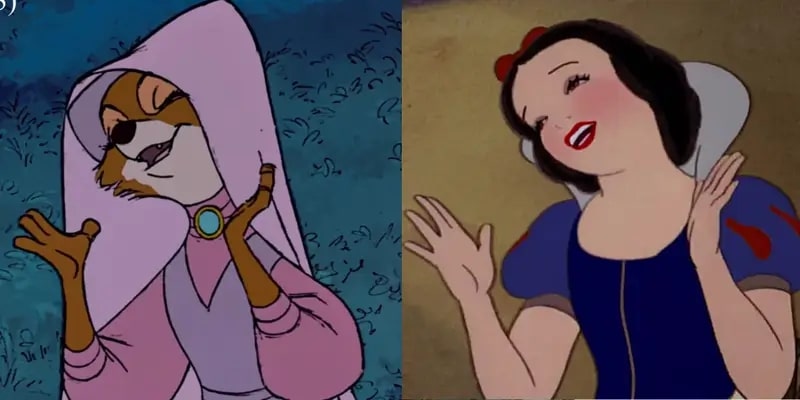
Have you ever noticed that Snow White does not once interact with the Prince (Fun Fact: his little-known name is Florian)? This makes her the only Disney Princess who does not speak to her love interest at all in the film.
While Snow White – the film – has won awards and has been recognized around the world for generations, Snow White – the character – was honored in 1987 with a star on the Hollywood Walk of Fame, making her the only Disney Princess to receive such an honor. Other Disney characters honored with a star include Mickey Mouse, Minnie Mouse, Donald Duck, Winnie the Pooh, and Tinker Bell.
Heigh Ho – The Seven Dwarfs
Short, sweet, and loveable – the seven dwarfs – Sneezy, Grumpy, Happy, Bashful, Sleepy, Dopey, and Doc – own a sacred place in Disney (and animation) history. These silly sidekicks were terrified of Snow White when they first met her. But when she won their hearts, they in turn won the hearts of filmgoers worldwide.
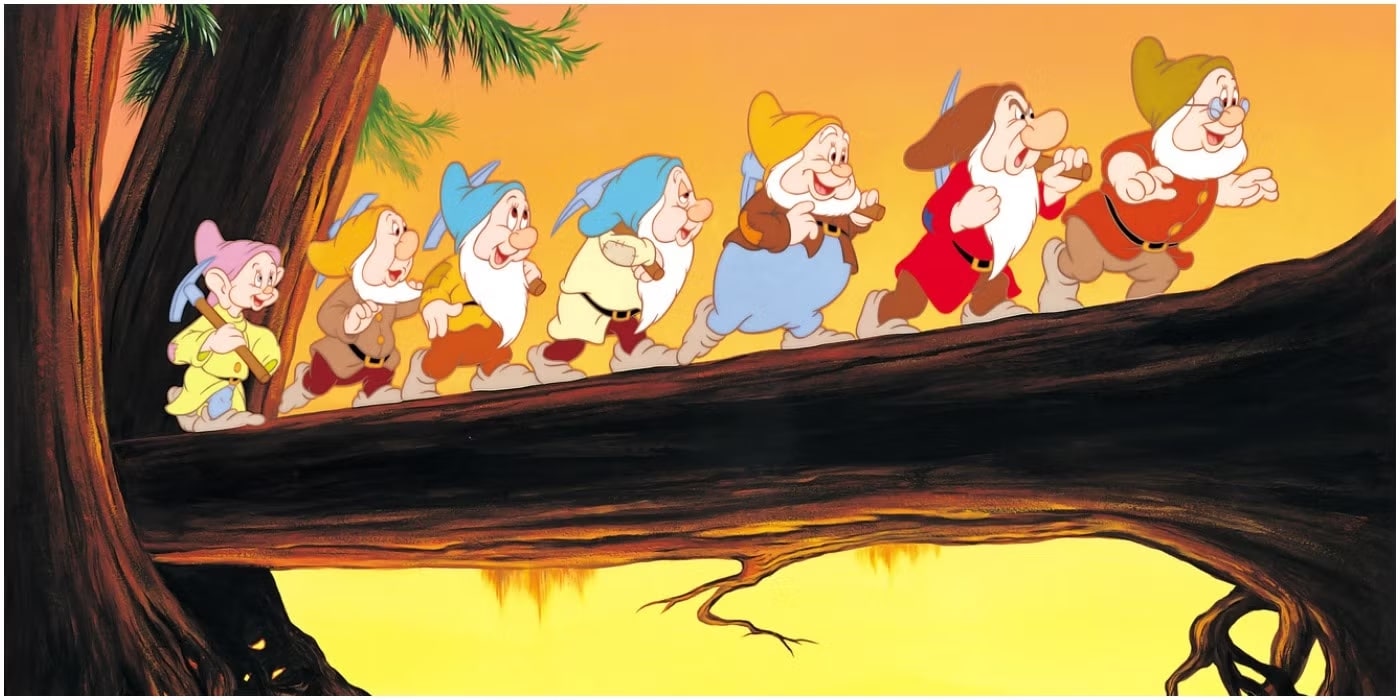
What’s in a Name?
Curiously, the dwarfs in the original Grimm Brothers fairy tale do not have individual names at all. A 1912 stage production of Snow White gave them the not-so-cuddly names Snick, Glick, Blick, Flick, Plick, Whick and Quee.
Before Disney settled on the names we know and love, the storytellers bounced around quite a few other names, spanning the spectrum between “quite cute” and “pretty poor.” Since there are dozens, I won’t list all the names here, but a few of the candidates included Awful (“He steals and drinks and is very dirty”), Biggy-Wiggy, Blabby, Deafy, Dirty, Gloomy, Hoppy-Jumpy, Nifty, Shifty, Weepy, Hungry, Lazy, Stubby, Wheezy, Shorty, Helpful, Silly, and Daffy.
Is it “Seven Dwarfs” or “Seven Dwarves”?
So what exactly is the plural form of the word “dwarf”? The short answer is…both! When Snow White was released, the generally accepted plural form of dwarf was “dwarfs”. But author J.R.R. Tolkien popularized the previously uncommon variant “dwarves” in his novels The Hobbit and Lord of the Rings. As a result, many people (including me) often incorrectly refer to “dwarves” in the Disney film, even going so far as to mislabel the film Snow White and the Seven Dwarves.
Adorable Dopey
Of all the dwarfs who befriend Snow White, Dopey is the overwhelming favorite. He is the most unique of the seven, which makes him the most memorable. Aside from the fact that he is the only dwarf without a beard, he is also the tallest, and the only one who doesn’t speak. He is also the silliest dwarf. Add it all together, and it makes Dopey appear as the youngest of the dwarfs, no doubt helping his appeal with younger audiences.
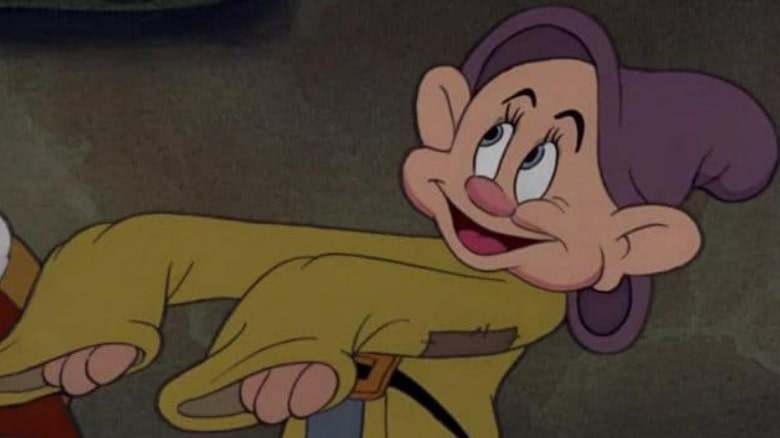
Dopey’s stardom was sky-high after the release of Snow White. With so much popularity, he was initially considered for the character of the apprentice in “The Sorcerer’s Apprentice” segment of Disney’s 1940 film Fantasia – a role that went to Mickey Mouse. Evidence of Dopey’s influence on Fantasia exists in the form of Mickey’s shirt sleeves. When Snow White asks to inspect his Dopey’s hands, his sleeves are comically too long. When plotting out “The Sorcerer’s Apprentice,” this same visual detail was used for Mickey.
The Evil Queen – The Greatest Villain of Them All
Every hero benefits from a counterbalancing villain, and Snow White contrasts beautifully against one of the greatest villains of all time – Evil Queen Grimhilde. In the American Film Institute’s 2003 list of the 50 Best Movie Villains of All Time, the Evil Queen ranked tenth, and was the highest-ranked animated villain.
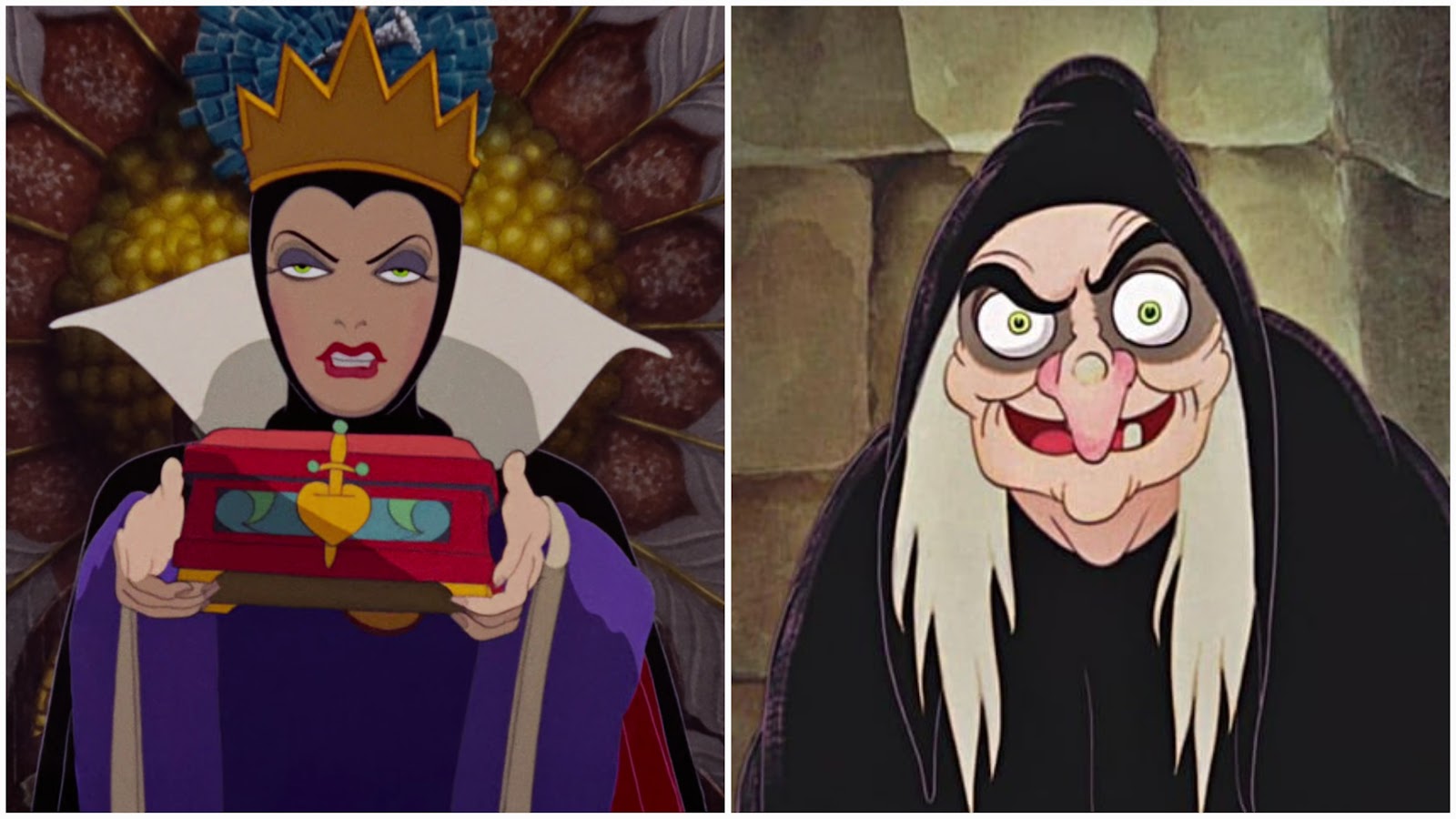
One of the aspects of the Queen that makes her most memorable is her alter ego – the Old Hag (often called the Old Witch). Disney’s depiction of the hag has influenced countless renditions of a hag-like witch over the decades since the film’s release, making the character practically synonymous with Halloween.
The voice for both personalities of the Queen were provided by the same person – Lucille La Verne. Having already been cast as the Queen, La Verne was told by Disney animators that they needed an older, raspier version of the Queen’s voice for the Old Hag. La Verne had just the trick. She stepped out of the recording booth, returned a few minutes later, and gave a perfect “Old Hag voice” that immediately won over the animators. When asked how she did it, she replied, “Oh, I just took my teeth out.”
The Old Hag adds to her sinister scariness when she occasionally turns to the camera, breaking the fourth wall to peer at the audience. While addressing the audience was fairly common in vaudeville performances of the day, the Old Hag was one of the first characters to do this in film.
Bonus: Do You Want to Know a Secret?
“Do you promise not to tell? When you’re standing by a wishing well, make a wish into the well, that’s all you have to do, and if you hear it echoing, your wish will soon come true.”
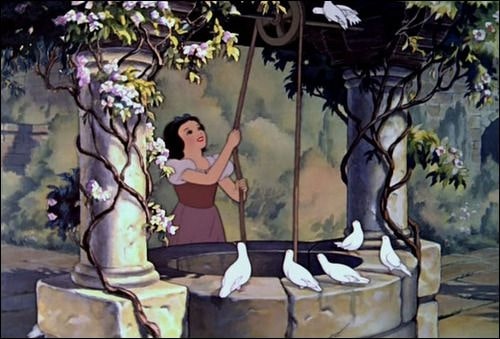
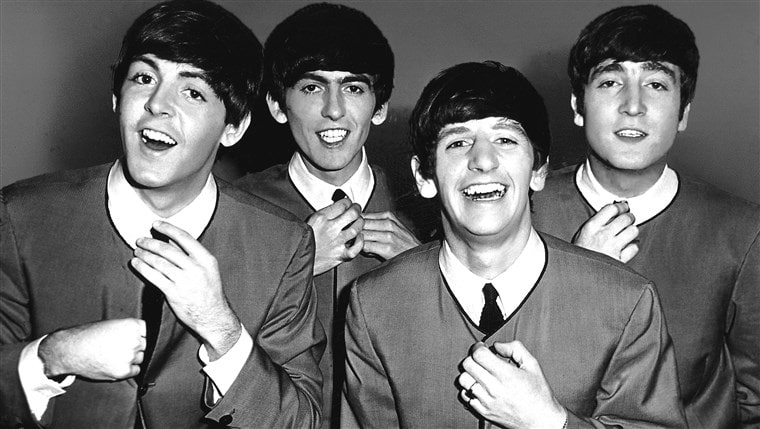
Snow White first sang these words on the silver screen in 1937. Music legend and Beatles member John Lennon had fond memories of Snow White as a child, when his mother used to sign him the “wishing well song.” Those childhood memories inspired him to write the Beatles hit song “Do You Want To Know a Secret” in 1963, at the heart of Beatlemania. Fellow Beatle George Harrison took the lead on vocals for the iconic tune.
Fun Fact: The Beatles honored Snow White further, in the form of a small statue included on the Beatles’ legendary album cover for Sgt. Pepper’s Lonely Hearts Club Band.
Snow White and the Seven Dwarfs has gone down in history as being one of the most influential movies of all time. The groundbreaking innovations, the pure heart, and the blood, sweat, and tears that went into the film’s production make it a true work of art.
Where does Snow White rank on your list of memorable Disney Princesses? Let me know what you think by joining the conversation on social: Instagram Facebook X
Sources:
Snow White and the Seven Dwarfs – IMDB
Disney Legends Page – Adriana Caselotti
Disney Connections – The Beatles – Jim Smith, Facts and Figment, March 6, 2024




